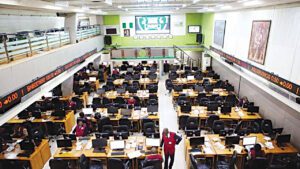Nestlé Nigeria’s N124bn forex loss drops H1 shareholders’ fund
A foreign exchange loss of N123.8 billion has created a net loss of roughly N50 billion for Nestlé Nigeria Plc in the half year of 2023, throwing shareholders’ funds into a negative of N48.6 billion.
The interim financial report of the Food and Beverages company for the half year ended June 2023 shows that the second quarter produced a net loss of N58.7 billion, which has wiped off over N16 billion profit in the first quarter as well as an equity base of over N30 billion at the beginning of the year.
Rising debts and interest expenses were the company’s main challenges in the first quarter, which caused a decline in after-tax profit from almost N18 billion in the same period last year.
Finance expenses continued to multiply, as interest-bearing debts continued swelling from about N155 billion at the end of 2022 to the region of N300 billion at the end of half a year.
Finance expenses jumped by 188.5 per cent year-on-year to almost N14 billion while foreign exchange losses flew from a little over N2 billion to nearly N124 billion over the period.
The figures added up to a total finance cost of N137.7 billion at the half year – close to 20 times the finance cost of less than N7 billion the company recorded in the same period last year.
Finance income went up from N4.5 billion to N7.8 billion over the period, which lowered net finance costs to about N130 billion compared to N2.4 billion in the same period in 2022.
The second quarter accounted for N121.7 billion of the finance cost at half year and N118.7 billion of the net finance cost as well. The quarter ended with a pre-tax loss of N86.5 billion which was brought down by a tax credit of N27.8 billion leaving a net loss of N58.7 billion for the quarter.
The second of the two major expense lines that have continued to pressure the company’s earnings so far this year is marketing and distribution cost — which continue to grow well ahead of sales revenue.
At over N40 billion in the half year, marketing and distribution costs rose by over 42 percent year-on-year – more than two and a third times an increase of 17.6 per cent in sales revenue to N261.8 billion at the end of June 2023.
However, the cost of sales slowed down relative to sales revenue over the review period at an increase of 8.6 per cent to N154.4 billion.
Cost savings from production costs enabled a gain in gross profit margin, leading to an increase of 33.8 per cent in gross profit standing at over N107 billion in the half year.
Despite the strong growth in marketing and distribution expenses, the company still grew operating profit by 31.6 per cent to N60.8 billion in the half year.
The figure represents an increase of N14.6 billion in operating profit – which was consumed by net finance costs of N130 billion. The outcome is a pre-tax loss of over N69 billion, a plunge from a pre-tax profit of N43.7 billion in the same period last year.
An income tax credit of N19 billion for the half year brought the net loss position down to roughly N50 billion for the company at the half year. This is against an after-tax profit of N27.7 billion in the corresponding period in 2022.
The loss hit the company’s capital account, turning retained earnings of N29.8 billion at the beginning of the year into negative N49 billion and shareholders’ funds also from over N30 billion to negative N48.6 billion over the same period.
Cash flow pressure facing the company eased somewhat at half year with a strong improvement in net cash generated from operating activities at N6.4 billion though the figure was grossly insufficient to fund net cash of N10.6 billion used in investing activities.
This informed management’s resort to aggressive borrowings, which has raised total liabilities by 32.4 percent to stand at N509 billion or 110.6 percent of total assets of N460.6 billion at half year close.
The loss at half year amounted to N74.04 per share, down from earnings per share of N12.33 in the same period last year.




